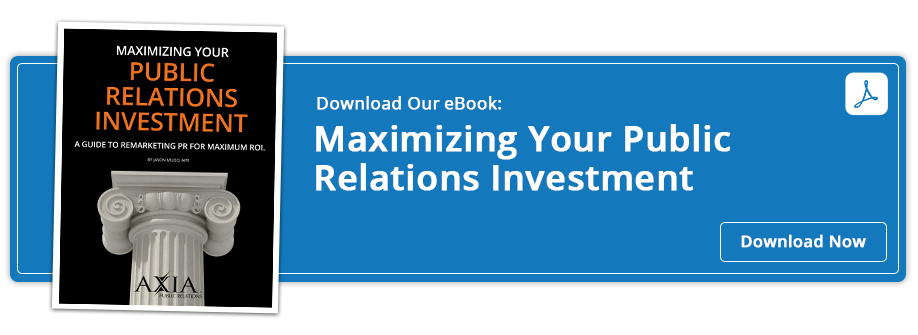Why top-tier media coverage may not be the most effective PR strategy
By Lindsey ChastainFebruary 21, 2024
Top-tier media coverage is a surefire way to expand brand visibility, yet it’s not the only option for your company.
 In the complex world of public relations, securing coverage in top-tier media outlets like The New York Times or The Wall Street Journal is often seen as the ultimate achievement for brand visibility. However, this may not always be feasible or even the most effective strategy for many companies.
In the complex world of public relations, securing coverage in top-tier media outlets like The New York Times or The Wall Street Journal is often seen as the ultimate achievement for brand visibility. However, this may not always be feasible or even the most effective strategy for many companies.
Audio: Listen to this article.
Companies should look beyond mainstream media and adopt a broader approach to get their message heard. For those seeking to enhance their company’s profile and establish thought leadership, there are alternative PR strategies that can help build industry credibility, connect with niche audiences, and shape brand perception.
(See also: How to measure and categorize the five tiers of news media outlets)
The Power of Trade Publications
Trade publications play a crucial role in shaping a company's reputation and act as one of the top publishers of press releases and pitches. They offer in-depth coverage of industry-specific news, trends, and innovations, often providing a level of detail mainstream publications can’t match.
According to a research study, 47% of B2B buyers get product information through publications they trust and read regularly. This suggests a significant percentage of companies use trade publications to shape their reputation. Additionally, trade publications offer a unique opportunity for businesses to communicate directly with their desired audience.
For instance, an insurance company launching a new policy might struggle to attract attention from mainstream media. However, a respected insurance trade publication feature could reach a targeted audience of industry professionals and potential customers, providing valuable exposure.
Similarly, a construction company using a new, eco-friendly building technique might not make headlines in The Wall Street Journal but could be featured in a construction trade magazine, positioning the company as an innovator in its field.
Building Relationships with Media
Developing and nurturing relationships with journalists and editors is fundamental for a successful PR strategy. This process, often referred to as media relations, involves more than sending press releases or pitches; it requires a proactive, thoughtful approach to engagement cultivated in several ways.
- Regular Social Engagement: Many journalists and editors maintain active social media profiles, particularly on platforms like X and LinkedIn. Following these professionals and engaging with their posts can help build relationships by reposting content, responding to posts, or participating in discussions they initiate. Regular, meaningful engagement can help you stand out from the crowd and establish a rapport over time.
- Relevant News: Journalists and editors are always on the lookout for interesting stories. By sharing news relevant to their beat, you can position yourself and your company as valuable sources of information. This could involve sharing news about your company, as well as sharing industry news, research findings, and trends the journalist might not be aware of. The key is to provide value and help them in their job.
- Insightful Comments on Industry Trends: Journalists often need expert sources to provide insights or quotes for their stories. By offering insightful comments on industry trends, you can establish yourself as a go-to expert in your field. This could involve reaching out to journalists directly with your insights or publishing your thoughts on your own platforms, like a company blog or LinkedIn post, before sharing these with journalists.
- Understanding Journalists' Needs: Journalists often work under tight deadlines and receive numerous pitches each day. Being respectful of their time, providing information in a clear and concise manner, and responding promptly to their queries can go a long way in building a positive relationship.
- Exclusive Information: If possible, offering exclusive information or access to your company can be a powerful way to build relationships with journalists. This could involve offering an exclusive interview with a company executive, or giving a journalist early access to a new report or research findings.
Leveraging Bylines and Other Media Opportunities
Byline articles, also known as op-eds or guest articles, are a unique and powerful tool in a company's PR arsenal. These articles are written by an expert from the company and published in an external publication –– often a trade or industry-specific magazine. The author's name appears at the top of the article, signifying their ownership of the ideas and insights presented.
Byline articles offer several key benefits:
- Establishing Credibility: Byline articles allow a company's expert to share their knowledge and insights directly with readers. This can help to establish the author, and by extension, the company, as a credible and reliable source of information within their industry. For example, an insurance executive writing about emerging trends in the insurance industry can demonstrate their deep understanding of the sector, enhancing their credibility among peers, customers, and potential partners with the ultimate goal of improving sales.
- Showcasing Thought Leadership: Byline articles provide an opportunity for a company's expert to delve into complex industry issues, share innovative ideas, or offer a unique perspective on current trends. For instance, a construction expert could write a byline article about the potential of sustainable building practices, positioning their company at the forefront of environmental responsibility in the construction industry.
- Control Over Content: Unlike traditional media coverage, where the journalist controls the narrative, byline articles give the author control over content. This allows the company to communicate its key messages effectively.
- Building Relationships with Media: By providing high-quality, relevant content, a company can become a valued resource for the publication. This can lead to further opportunities for coverage and collaboration in the future.
- Reaching Target Audiences: Byline articles in industry-specific publications can reach a highly targeted audience of industry professionals, potential customers, and influencers. This can be particularly effective for companies in specialized sectors, such as dental products or services, where a focused, industry-savvy audience may be more valuable than a broader, mainstream audience.
While securing coverage in top-tier media outlets is often seen as the ultimate PR achievement, it's important to recognize the value of alternative strategies. Trade publications, building relationships with media, and leveraging bylines and other media opportunities can establish exposure and a company's reputation as an industry leader.
Download our “Learn Media Relations from The Media” e-book for additional tips on interacting and connecting with the media.
Photo by Pixabay
Topics: media relations, earned media, news media


Comment on This Article